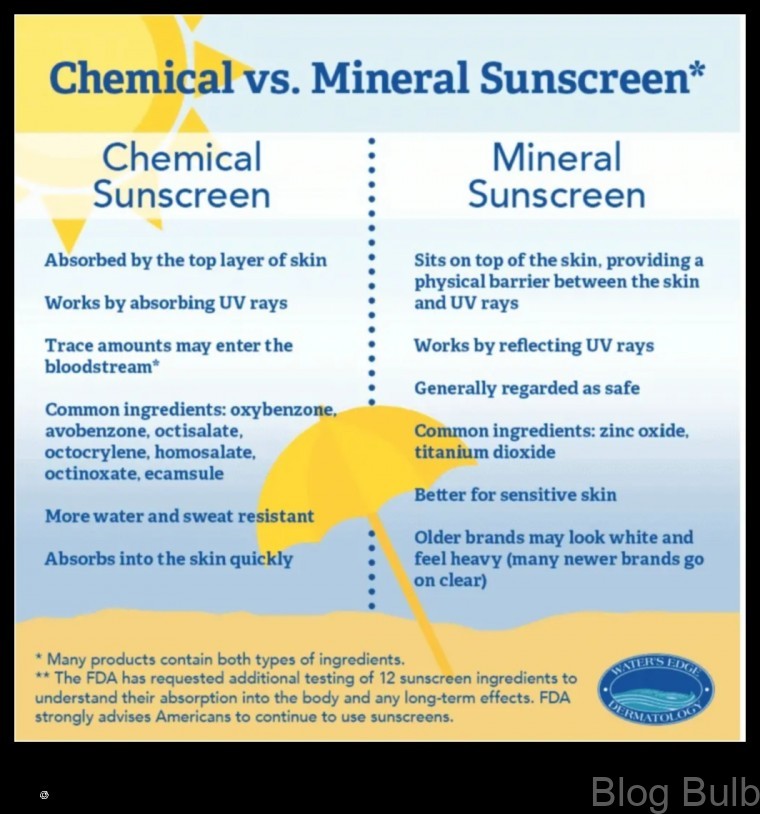
Table of Contents
Mineral vs Chemical Sunscreen: Know the Difference
Sunscreen is an essential part of protecting your skin from the sun’s harmful UV rays. But with so many different types of sunscreens on the market, it can be hard to know which one is right for you.
In this article, we’ll take a closer look at mineral and chemical sunscreens, and help you decide which type is best for you.

Types of Sunscreens
There are two main types of sunscreens: mineral sunscreens and chemical sunscreens.
Mineral sunscreens contain active ingredients that reflect or scatter the sun’s UV rays, while chemical sunscreens contain active ingredients that absorb the sun’s UV rays.
Mineral Sunscreens
Mineral sunscreens are typically made with zinc oxide or titanium dioxide. These ingredients are safe for all skin types, and they are less likely to cause skin irritation than chemical sunscreens.
Mineral sunscreens can also be more effective at protecting against UVA rays, which are the type of UV rays that cause skin aging and wrinkles.
However, mineral sunscreens can sometimes leave a white cast on the skin, and they may not be as water-resistant as chemical sunscreens.
Chemical Sunscreens
Chemical sunscreens are typically made with ingredients such as oxybenzone, avobenzone, and octinoxate. These ingredients absorb the sun’s UV rays, and they help to protect the skin from sunburn.
Chemical sunscreens are generally more lightweight and cosmetically elegant than mineral sunscreens. They are also more water-resistant.
However, chemical sunscreens can sometimes cause skin irritation, and they may not be as effective at protecting against UVA rays as mineral sunscreens.
Benefits of Mineral Sunscreens
Mineral sunscreens offer a number of benefits, including:
- They are safe for all skin types, even sensitive skin.
- They are less likely to cause skin irritation than chemical sunscreens.
- They are more effective at protecting against UVA rays, which are the type of UV rays that cause skin aging and wrinkles.
Benefits of Chemical Sunscreens
Chemical sunscreens offer a number of benefits, including:
- They are generally more lightweight and cosmetically elegant than mineral sunscreens.
- They are more water-resistant than mineral sunscreens.
- They are typically more affordable than mineral sunscreens.
Drawbacks of Mineral Sunscreens
Mineral sunscreens can sometimes have drawbacks, including:
- They can leave a white cast on the skin.
- They may not be as water-resistant as chemical sunscreens.
- They can be more expensive than chemical sunscreens.
Drawbacks of Chemical Sunscreens
Chemical sunscreens can sometimes have drawbacks, including:
- They can cause skin irritation, especially in people with sensitive skin.
- They may not be as effective at protecting against UVA rays as mineral sunscreens.
- Some chemical sunscreen ingredients have been linked to health concerns, such as coral reef damage and endocrine disruption.
Which Type of Sunscreen is Right for You?
The best type of sunscreen for you depends on your individual needs and preferences.
If you have sensitive skin, you may want to choose a mineral sunscreen. Mineral sunscreens are less likely to cause skin irritation than chemical sunscreens.
If you are looking for a sunscreen that is lightweight and cosmetically elegant, you may want to choose a chemical sunscreen. Chemical sunscreens are typically more lightweight and cosmetically elegant than mineral sunscreens.
- Uses chemical compounds to absorb UV rays
- Available in both lotion and spray forms
- Can be more drying to the skin than mineral sunscreens
- May cause skin irritation for some people
- Uses mineral compounds (such as zinc oxide and titanium dioxide) to reflect UV rays
- Available in both lotion and cream forms
- Can be more greasy or heavy than chemical sunscreens
- May leave a white cast on the skin
Introduction
Sunscreen is an important part of protecting your skin from the sun’s harmful UV rays. There are two main types of sunscreens: mineral and chemical. Mineral sunscreens work by reflecting the sun’s rays, while chemical sunscreens work by absorbing the sun’s rays.
III. Benefits of mineral sunscreens
Mineral sunscreens are made with zinc oxide or titanium dioxide, which are natural minerals that reflect the sun’s rays. This makes them very effective at blocking both UVA and UVB rays, which are the two types of ultraviolet radiation that can damage your skin.
Mineral sunscreens are also less likely to cause skin irritation than chemical sunscreens, making them a good option for people with sensitive skin.
Additionally, mineral sunscreens are often water-resistant, so you can reapply them less frequently than chemical sunscreens.
Overall, mineral sunscreens are a safe and effective way to protect your skin from the sun’s harmful rays.
Benefits of mineral sunscreens
Mineral sunscreens are made with natural ingredients, such as zinc oxide and titanium dioxide. These ingredients sit on the surface of the skin and reflect the sun’s rays, providing protection from both UVA and UVB rays.
Mineral sunscreens are generally considered to be more gentle on the skin than chemical sunscreens, and they are less likely to cause irritation or allergic reactions.
Mineral sunscreens are also waterproof and sweat-proof, making them a good choice for outdoor activities.
V. Drawbacks of mineral sunscreens
Mineral sunscreens can have some drawbacks, including:
- They can leave a white cast on the skin.
- They can be more difficult to apply evenly than chemical sunscreens.
- They can be more expensive than chemical sunscreens.
However, mineral sunscreens are generally considered to be more gentle on the skin and less likely to cause irritation or allergic reactions. They are also more effective at blocking both UVA and UVB rays.
Mineral Vs Chemical Sunscreen: Know the Difference
Chemical sunscreens and mineral sunscreens are two different types of sunscreen that offer different levels of protection from the sun’s harmful UV rays. Both types of sunscreens have their own advantages and disadvantages, and the best type of sunscreen for you will depend on your individual needs.
In this article, we will discuss the difference between mineral and chemical sunscreens, the benefits and drawbacks of each type, and how to choose the right sunscreen for you.
Which type of sunscreen is right for you?
There are a few factors to consider when choosing a sunscreen, including your skin type, activity level, and climate.
If you have sensitive skin, you may want to choose a mineral sunscreen, as these are less likely to cause irritation. Chemical sunscreens can sometimes cause stinging or burning on sensitive skin.
If you are very active, you will need a sunscreen that is water-resistant and sweat-proof. Mineral sunscreens can be more difficult to reapply than chemical sunscreens, so you may want to choose a chemical sunscreen if you are sweating a lot.
If you live in a sunny climate, you will need a sunscreen with a high SPF. Mineral sunscreens typically have a lower SPF than chemical sunscreens, so you may want to choose a chemical sunscreen if you live in a sunny area.
Ultimately, the best sunscreen for you is the one that you will use consistently. If you don’t like the way a sunscreen feels on your skin, you are less likely to use it regularly. So, it is important to find a sunscreen that you are comfortable with and that meets your needs.
How to apply sunscreen
To apply sunscreen correctly, follow these steps:
- Apply sunscreen 15 minutes before going outside, even on cloudy days.
- Use enough sunscreen. The general rule of thumb is to apply 1 ounce of sunscreen, or enough to fill a shot glass, for your entire body.
- Reapply sunscreen every 2 hours, or more often if you are sweating, swimming, or toweling off.
- Be sure to apply sunscreen to all exposed areas of skin, including your face, ears, neck, back, and feet.
- If you are using a spray sunscreen, be sure to spray it in the air and then walk through it so that you don’t miss any spots.
By following these tips, you can help protect your skin from the harmful effects of the sun’s UV rays.
How often to reapply sunscreen
The American Academy of Dermatology (AAD) recommends reapplying sunscreen every two hours, or more often if you’re sweating, swimming, or toweling off. This is because sunscreen can wear off over time, and you need to reapply it to maintain your protection from the sun’s harmful rays.
If you’re not sure how often to reapply your sunscreen, it’s always better to err on the side of caution and reapply more often than you think you need to. This will help you protect your skin from sunburn and other harmful effects of the sun.
FAQ
Q: What is the difference between mineral and chemical sunscreens?
A: Mineral sunscreens contain active ingredients that reflect or scatter the sun’s rays, while chemical sunscreens contain active ingredients that absorb the sun’s rays.
Q: Which type of sunscreen is better for my skin?
A: The best type of sunscreen for you depends on your skin type, activity level, and climate.
Q: How do I apply sunscreen correctly?
A: To apply sunscreen correctly, follow these steps:
- Apply sunscreen 15 minutes before going outdoors.
- Apply enough sunscreen to cover all exposed skin.
- Reapply sunscreen every 2 hours or after swimming or sweating.
Maybe You Like Them Too
- How to Detangle Curly Hair Without Damaging It
- Sole Mates A Guide to Finding the Perfect Shoes for Every Outfit
- Beauty Beyond Borders When Fashion and Makeup Collide
- 50 Chic Wedding Hairstyles for the Modern Bridesmaid
- The Best Shampoos for Hair Extensions A Guide to Keeping Your Extensions Healthy



